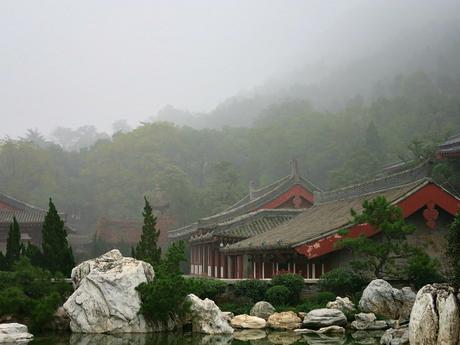
So, Xi’an is on your itinerary?
In my mind, there are a couple of reasons you might find yourself in this second tier city in the middle of China.
One: it’s considered the undisputed root of Chinese civilisation one of China’s oldest cities with enough history to rival a museum on steroids!
Or two: you’re taking pity on expats like me who need a sanity check in the shape of your visit (note: absolutely NO entry without cadbury chocolate bar in hand)!
If it’s the former, (bring chocolate anyway) your main focus is probably those blokes who make up that world-famous terra-cotta army, right?
For most visitors, it’s a quick stop over, usually after a whistle stop tour of Shanghai and Beijing.
So, with time of the essence, I’ve put together a quick list to tick off, if you’re just in town for a couple of days and don’t want to miss the key things.
Of course there are plenty of other ‘interesting’ things to see, but I’ll save those for another day and a longer stay!
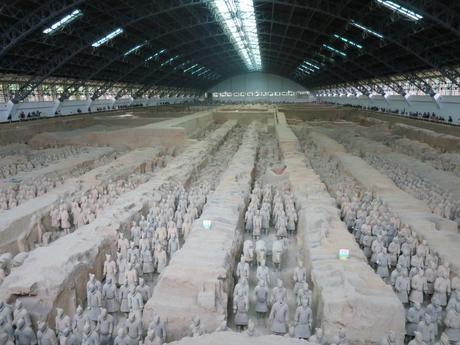
1) Terracotta Warriors
These guys are definitely a fascinating sight to see. I’ve seen them twice now and while I wouldn’t probably recommend a third time, they are a once in a life time experience.
There’s a compelling story behind their great unearthing, which you need to read all about here in my post before you set foot in the pits: Xian’s Terracotta Warriors: The Largest Jigsaw in the World.
Meantime, here are the details:
Where are the Terracotta Warriors?
This clay army of soldiers is, as you’d expect, quite a distance from the city itself in Lintong. To be precise it’s 40 kilometres from Xi’an city or just over an hour from the airport, so be sure to work out your mode of transport in advance. (Xi’an is geographically a widespread city, so getting from one side to the other is not always easy. Friday and Saturday nights are mayhem on the roads!)
(REPEAT: Mayhem!)
How to get to the Terracotta Warriors:
Take a Taxi (green ones only).
From the airport, the cost is roughly RMB150-200.
From the city, the cost is around RMB110-120
From the airport, you can also take the Airport Shuttle Line 2 to Xi’an Railway Station and then walk to the east square of the railway station to catch bus 914/ 915 or tourist line 5 (no. 306) to the warriors.
There are also plenty of busses travelling from all parts of the city. Click here for specific details
Or, if that all sounds a little daunting, alternatively most hotels can provide you with a car and driver for hire!
Cost for the Terracotta Warriors:
Peak season (aka the hot season) is March to November and the entry fee is RMB150
For Low season (aka the cold season) in December to February, the entry fee is RMB120
Kids under 1.2 metres tall are FREE.
Opening Times at the Terracotta Warriors:
Summer: Tickets sold from 8:30am to 5:00pm – last check int at 18:35pm
Winter: Tickets Sold from 08:30am to 4:30pm – last check-in at 18:05pm
Time to spend at the Warriors:
I would suggest you put aside at least four hours including travel time. There are three ‘pits’ to view and while you can take as much or as little time as you choose checking these guys out, you probably need a good couple of hours, at least.
Tips for the Warriors:
*There’s not much in the way of restaurants/cafes apart from a fairly basic cafe and a couple of quaint tea rooms, so it can’t hurt to pack a lunch or eat beforehand, if you want to make it easy.
*Strollers are available if you’ve got little ones who aren’t keen to stay on their feet for the visit. There are also wheelchairs available.
*There is a walk from the entrance to the pits, and let me tell you, if it’s cold, you’ve got kids or elderly people with you, you want to grab the buggy.
*It is helpful to have a tour guide to explain the history and in my humble opinion adds a lot more value to the trip. Hire one at the site for around RMB100 or your hotel should be able to recommend a good one. (Usually a little more expensive.) Or, alternatively rent an audio guide for RMB40.
Extra Time:
The Huaqing Palace Heritage/Hot Springs are six kilometres from the warrior site, set at the base of Mt Lishan for some stunning landscape views on a clear day. (Note: To protect their heritage, you cannot go for a dip in these hot springs.) For more information, click here.
About 150 metres from is here is the Lintong Museum which has about 10,000 artefacts dating from the Stone Age to modern times.
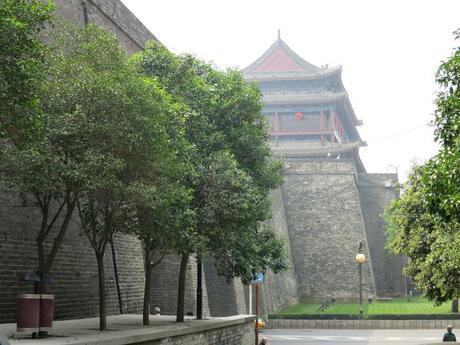
2) The City Wall
This is a 13 kilometre stretch that, along with a moat, embraces the city. As the most complete city wall that has survived in China, as well being one of the largest ancient military defensive systems in the world, let me say, it is definitely worth heading into the city to see, even if you don’t go up on to the wall itself.
If you do choose to go up, you can walk around the wall (if you’ve got the stamina and time) or grab a tandem bike if it’s a nice day (takes about two hours).
Otherwise the buggies are definitely the way to go and it gives you a great perspective of the city.
Where is the City Wall?
Right in the city’s hub. There are four gates leading through the wall into the city: North, South, East, West.
Opening Times for the City Wall:
South Gate: 8:00-22:00
East/North/West Gates:
Summer: 8:00-19:00
Winter: 8:00-18:00
Cost for the City Wall:
Tickets can be purchased at the bottom of the wall near the South Gate for 54RMB
27RMB for kids between 1.2 and 1,4 metres tall. Children under this height are FREE.
Bike Cost:
Deposit RMB200
Single Bike RMB40 for 100 minutes
Tandem Bike RMB80 for 100 minutes
Buggy Cost:
RMB80
Time to spend at the City Wall:
You can be up here for as little or as long as you want. Taking the buggy around is about one hour and it stops at each gate for ten minutes, so you can jump off and stretch your legs and admire the view.
Tips for the City Wall:
*There are very steep stairs leading up to the wall, so it’s definitely not stroller friendly.
*Unless it’s a festive occasion with street food stalls set up, there is no food.
Extra Time:
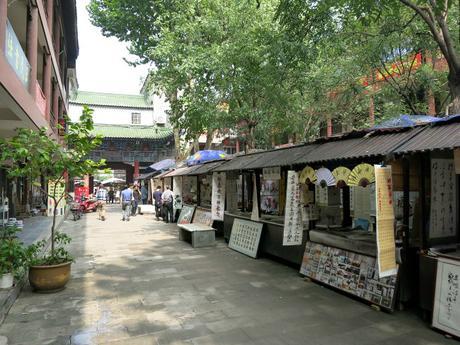
Once you’ve done the wall….if time permits just below the wall at the South Gate is the Ancient Cultural Street of Shuyuanmen where you’ll find quaint lane ways like something out of old Europe; markets sell all sorts of trinkets and beautiful calligraphy paintings.
Defu Lane is also parallel to the wall at the South Gate and a popular haven for bar hopping.
Warning: Don’t expect a thriving bar scene, but it’s an impressive spot at night.
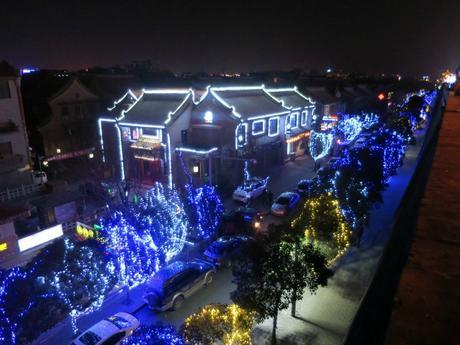
The South Gate is also close to both the Bell and Drum Towers.
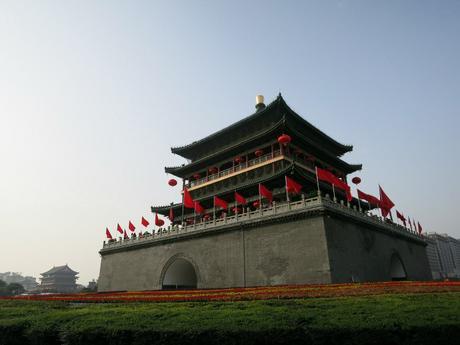
3) Bell Tower/Drum Tower (Zhong Lou/Gu Lou)
These two spectacles are right in the middle of the city and hard to miss.
The Drum Tower erected in 1380 during the early Ming Dynasty towers over the city with excellent views.
There is a huge drum inside that used to signal the end of the day.
If you want to, you can go inside and see the drum museum and a drum show, performed every day.
The Bell Tower was built in 1384 and marks the geographical center of the ancient capital. From this important landmark branch out East, South, West and North Streets that connect the tower to the East, South, West and North Gates of the City Wall. The Bell Tower is the largest and best-preserved of its kind in China.
Opening Times for the Bell/Drum Towers:
Summer: (April 1st – October 25th) 8:30am – 21:30
Winter: (October 26 – March 31st) 8:30am – 18:00
Cost for the Bell/Drum Towers:
Bell Tower: RMB35
Drum Tower RMB35
Bell/Drum Towers RMB50
Tips for the Bell/Drum Towers:
*If you prefer to stand back and gaze at the towers from a distance, you’ll still be glad you saw them. Take the time to stroll around the surrounding streets and soak up the atmosphere.
*The city REALLY comes to life at night. Try to see it at least once under lights.
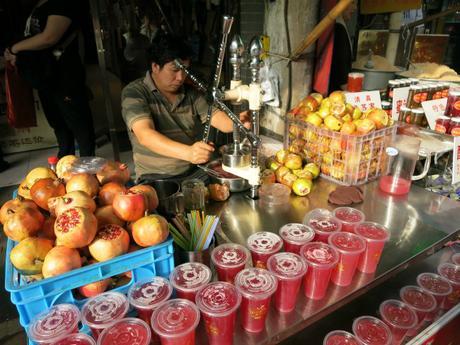
4) Muslim Quarter (Hui Min Street)
Xi’an was the start of the famous Silk Road trading route when many merchants traveled from the middle east to trade and many of their descendants are still living in Xian today, making up a 60,000 strong muslim community in the city.
Known as the ‘Muslim Quarter’ in English, the area is a colorful feast for both the eyes and tastebuds.
A window into the Chinese-Muslim culture, it’s a hive of activity covering several blocks where the tight knit community is busy around the clock, preparing a labyrinth of tasty sweet and savoury street food snacks, not to mention an overabundance of the city’s famous elixir ‘pomegranate juice!’
With an electric atmosphere, you can’t go past a visit to the Muslim Quarter. (Don’t forget the camera!)
Where is the Muslim Quarter:
In the heart of the city adjacent to the Drum Tower.
Time to spend at the Muslim Quarter:
You can meander through the bustling lane ways in about half an hour….
Cost for the Muslim Quarter:
No cost, but take some cash for the street food. There are quite a few market stalls selling traditional souvenirs too. (Head down the side lane ways for more markets. Two words ladies: cheap handbags!)
Tips for the Muslim Quarter:
*Try to avoid going here on a weekend, it will be packed to the rafters!!! It’s very hard to walk through (especially with a stroller) and much more pleasant on a quiet week day.
(Definitely steer clear if it’s any sort of festival or holiday!)
*Don’t forget to bargain if you’re buying from the markets.
*I am still not convinced the street food won’t have you calling for the Lomitel or its equivalent, so eat at your own risk. But! (there’s a but) I am told by locals, if it’s going to be safe anywhere, it’s here!
Extra Time:
Visit The Great Mosque for 15RMB. It’s one of the oldest, largest (covering 12,o00 square metres) and best-preserved Islamic mosques in China. Just northwest of the Drum Tower on Huajue Lane.
Cost:
Summer: RMB 25
Winter: RMB 15
(Etiquette rules apply.)
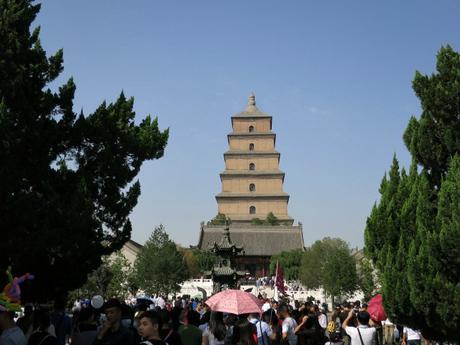
5) Big Wild Goose Pagoda (Dayan Ta)
Four kilometres south of the city, this is a buddhist pagoda built in the Tang Dynasty in 652 standing 64 metres high with views stretching out across the city. It was rebuilt in 704 with an extra five new storeys; however, a massive earthquake in 1556 heavily damaged the pagoda and reduced it by three stories, to its current height of seven stories.
It’s no Leaning Tower of Pisa but you’re not seeing things, it does lean several degrees to the west.
In the past it was used to hold sutras and figurines of the Buddha that were brought to China from India by a Buddhist translator and traveller. In 2014 it was added to the World Heritage List.
Where is the Big Wild Goose Pagoda?
QuJiang New District – about 20 minutes from the city on a good run.
This area has been designed with tourists in mind! Set at the site of the Daci’en Temple, the Pagoda stands tall amongst manicured gardens and paved squares where kites fly sky-high around the clock and 3-wheeler bicycles weave in and out of the crowds ferrying street food to passersby. There are several big shopping centres and a myriad of monuments to see amongst the tree-lined streets, not to mention the largest musical fountain in Asia.
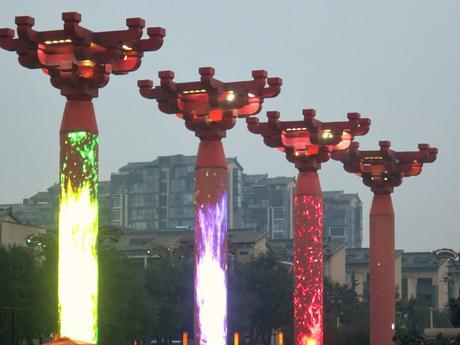
(I also know a great hotel across the road if you want to pop in.) ![]()
Opening Times for the Pagoda:
8:00 – 17:00
Cost for the Pagoda:
Daci’en Temple RMB50
Climbing the Pagoda RMB40
Tips for the Pagoda:
*If you are in this area and want to catch a Tuk Tuk or take a cab, 10-15 minutes up the road is a huge scenic lake. (Qujiang Pool Park 曲江池遗址公园) It’s a beautiful spot in Xi’an if the weather is on your side. Great for kids with plenty of bikes and paddle boats for hire (if you’re game!).

*Bar Street is just around the corner from the Pagoda. A stretch of cute cottage-like bars and restaurants, it’s worth taking a stroll up the street at least. (The Indian on the corner and the German Beer Cafe are local favourites.)
So there, you have it. That’s Xi’an in 48 hours.
See you when you get here!
This is China.

